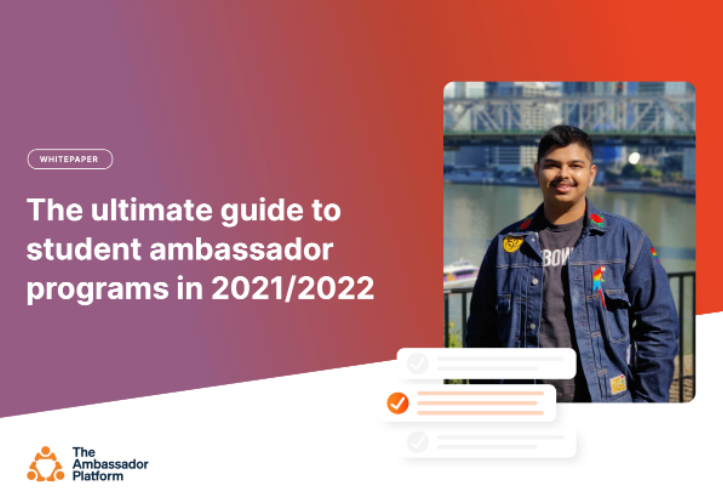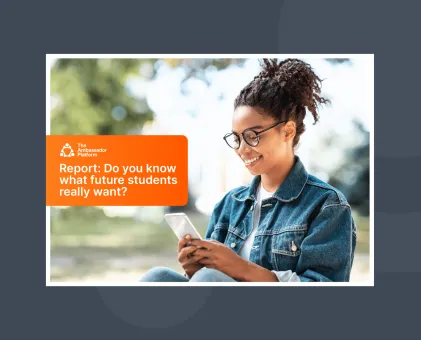How to recruit ambassadors and build an ambassador program

The first step in building your ambassador program is recruitment. This is where you pull together your squad of ambassadors who will help you embed the experience of your organisation across your recruitment and admissions cycle.
When you have thousands of students at your institution, choosing who to recruit to represent you can be challenging. It’s vital to ensure your ambassadors are from a variety of backgrounds, and study a range of subjects, so that your team is best positioned to help a variety of prospects, who may be from different backgrounds themselves or be interested in different topics.
Having ambassadors from different years of study is also important so prospects can hear from students at different stages of their education.
In this article, we’ll look at the following stages:
- Stage 1 - 'scoping': Defining the ambassador role for your institution
- Stage 2 - 'recruitment': Creating and advertising ambassador vacancies
- Stage 3 - 'assessment': How to choose your ambassadors
Let's get into it!
Stage 1 - 'scoping': Defining the ambassador role for your institution
Step one is simple; have you got a clear definition of an ambassador role for your institution? If not, make this your first step.
When thinking about what you actually want your ambassadors to do, you should think holistically; chatting with prospects via a platform like TAP is obviously important, but is only a part of it.
Other things to consider include:
Beyond chat
Not every prospect will want to engage in conversation with your ambassadors - they might be nervous, short on time, or just not interested. However, they will still want to access the sorts of insights your ambassadors can offer, and a great way to do this is by having your ambassadors create content that showcases their experience as part of your institution. That’s why we have the content and FAQ features on TAP. Content is a vital tool to build awareness and drive traffic through to your ambassadors, so put it at the heart of your planning from the start - and make sure ambassadors understand the importance of content creation as part of their role too.
Recruitment events
The benefits of using an always-on digital platform like TAP to manage your ambassador program means that you don’t have to structure your recruitment plans around specific events - there can always be an open window into your organization for prospects to chat through. But, if you’re still running standalone recruitment events you should definitely factor in how your ambassadors will be involved in them at an early stage. How many of these events will you expect your ambassadors to attend? How does their involvement change depending on whether those events are in-person or online?
There’s also a real benefit to using TAP to allow for any conversations that your ambassadors might start at an in-person event to continue online afterwards, for as long as they need to.
The University of Sydney once summed it up brilliantly to us; they'd heard from prospective students and parents that one of the things they loved about the way Sydney engaged with them was the fact that they would share content featuring students on different social platforms, then see these same students at recruitment events or on a webinar, then see them highlighted in an email, and finally when landing on the TAP page, see that those students were available to speak to. There was a consistent focus on the student experience throughout.
Added benefits
Working as an ambassador is not only an enjoyable role, but one that helps build tangible skills and boost your ambassadors’ employability - something they can easily track and use with the personalized career references available in our app. Beyond the skills they will build every day as an ambassador though, can you offer anything else to make the idea of joining your program more appealing? Will your ambassador program include a period of work experience in either your institution’s recruitment or marketing teams? Will ambassadors be able to give their input into your organization’s campaign planning and earn yet more experience for their resume/CV?
Basically, be sure to think deeply about what work you actually want your ambassadors to do for you, and make a clear plan before you even start to recruit them - it will give you more focus and allow you to ensure all of your work with your ambassadors is helping you achieve what you want to achieve.
Stage 2 - 'recruitment': Creating and advertising ambassador vacancies
Once you have a clear plan for what you want your ambassador program to look like and what you want your ambassadors to do, the next step is to put those roles together and get the word out there! This means job descriptions, adverts and promotions, and anything else you can do to build interest in your new vacancies.
Be sure to make any job adverts you create accessible and work hard to make the roles themselves inclusive and representative. You don’t just want to recruit an entire team of the same sort of person - ideally, your ambassador team will be a true reflection of your wider student body and be as diverse as possible. You want to give as many prospective students as possible the chance to find an ambassador who feels like a good match to them.
Writing job descriptions
When promoting your program, you’ll almost certainly want to point those interested to a job description, something that outlines what is expected of them should their application be successful.
These job descriptions will vary from institution to institution, but some things you might like to include are the fact that ambassadors will be expected to download an app to their phone and to commit to completing our training center. You should then also outline what sort of work they will actually do - having conversations online with prospects, as well as creating content and answering FAQs - and having a profile on your institution’s website.
You might want to get into specifics about how many hours they would be expected to work, what their pay will be if you’re able to pay them, and anything else specific to your scheme or your institution’s policies around job descriptions for student roles.
Advertising your vacancies
When it comes to advertising your ambassador vacancies, it’s about exploiting whatever opportunities you have to promote your ambassador program and encourage people to put themselves forward. Here are a few ideas for you.
Social media has a wide reach across your community and is great for getting the word out that you're looking for a broad range of people interested in representing your institution and building their own employability skills.
For universities and colleges, a stand at something like a Freshers' Fair/ Student Orientation is a great way to reach a huge portion of the community, especially first years who will be very well placed to engage with prospects making their education decision. And don’t overlook things like job boards; anyone actively looking at those boards will definitely be interested in taking on some work, so they’re also a key place to advertise.
Simply sending an email campaign to specific groups to advertise the opportunity to represent their department/team/course/faculty could also be a good tactic, as well as speaking to academics or managers, asking them for recommendations of candidates who might represent their team well.
Create a buzz: finding the added extras to shout about
Something else you should look to actively promote to your potential ambassadors - either in the job description or as part of your wider promotional campaign, is the impact the work of an ambassador has and the added benefits of working such a role.
When it comes to impact, your ambassadors will be able to help prospects make a life-changing decision in a more confident and informed way, get involved in wider marketing and recruitment, helping represent the institution on a bigger scale, and contribute to your institution’s marketing channels to reach audiences far and wide and give them an authentic window into life at the institution.
A lot of those points of impact are also tangible benefits of being an ambassador - they’ve got a real opportunity to help shape how their institution interacts with prospects and build some tangible personal career milestones, which is really valuable.
Beyond those, the key thing to stress is that being an ambassador is real-life work experience. It is a job regardless of whether or not they’re paid. As mentioned above, on TAP your ambassadors will have access to an up-to-date automated reference that is not only certified by the institution, but verified by The Ambassador Platform. They can use this reference in future job applications, on their CV, and wherever else it might be useful.
Stage 3 - 'assessment': how to choose your ambassadors
The final thing to think about when it comes to recruitment is how you’re going to assess your applicants and pick your ambassadors. You might want to interview them, you might ask them to submit examples of content as part of their application, or you might want to do something totally different.
However you assess your potential ambassadors, our strong advice would be to come up with a way of learning more about your applicants and, crucially, why they want to be one of your ambassadors.
Holding interviews is a great way for you to get a sense of your applicants - although do bear in mind some of them might be nervous. You could run these interviews in person, via Zoom, or even over the phone.
You should try to make them as relaxed as possible, and come up with questions that will let your applicants’ personality and passions come out. Some questions you might like to ask could be…
- Why have you applied to be an ambassador?
- What do you think the role of an ambassador is?
- What skills and/or experience do you have that would enable you to be a successful ambassador?
Another very worthwhile part of an ambassador program application process is to ask your candidates to create and share some content with you - this will give them an idea of the sort of thing they might be doing if they get the role, and allow you to see their potential. Also, it puts a focus on the importance of content for your ambassadors right from the start of the process.
Some examples of content creation tasks you could set include…
- A photo of their favourite place on campus/in the city, with a short caption explaining why they love it so much
- A short video to talk through their motivations of why they want to be an ambassador
- A video explaining what they would share with a prospect if they wanted to summarise the experience of being part of your institution
Remember, the assessment process isn’t just for you to find good candidates; it should allow your applicants to get an even better understanding of what the role entails and allow them to decide if it is something they want to do. With that in mind, make your assessment process reflective of the role, and allow opportunities for your candidates to ask you questions too.
Ambassador programs shouldn’t just be set up as a benefit to your organization; they should also be built in a way that supports your team of ambassadors and allows them to build real, transferable skills. Set clear goals for your program as early as you can, recruit against those goals, and you will be on your way to building a terrific squad of enthused and valuable ambassadors!
Download our free guide
Our whitepaper gives you an in depth look at how to start and run a successful student ambassador program including:
- Planning your program
- Recruitment
- Managing your ambassadors
- Incentivization and payment
- Tools to support



